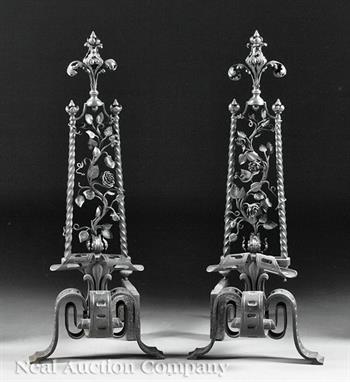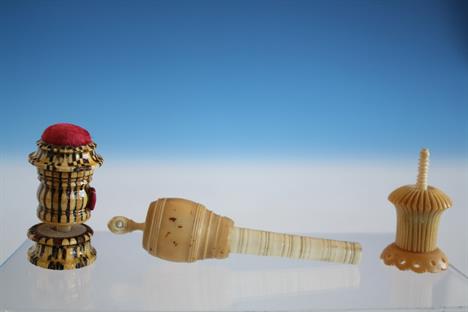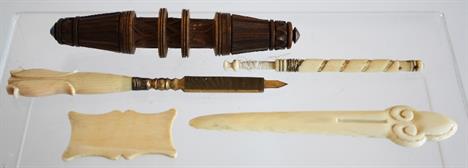We found 116099 price guide item(s) matching your search
There are 116099 lots that match your search criteria. Subscribe now to get instant access to the full price guide service.
Click here to subscribe- List
- Grid
-
116099 item(s)/page
A pair of polished brass and wrought iron mounted fire dogs in Louis XIV taste, late 19th century, each with flambeau finial above a foliate cast and lobed urn, on rectangular section socles with foliate cast bases, each on two feet cast as stylised dolphins, the iron billet bars behind, 66cm high, 31cm wide, 72cm deepBid Live at the-saleroom.com
A pair of brass andirons, late 19th century, each with flambeau finial above waisted, knopped and foliate cast uprights, rising above female headed winged sphinx torsos, before scroll cast front legs, the knopped billet bars each to a single back leg, 52cm high, 28cm deepBid Live at the-saleroom.com
A set of three ebonised and gilt metal three light wall appliqués in the Louis XVI style, early 20th century, the foliate cast urn sockets on circular drip pans with fluted undersides, on reeded stems rising from foliage and a bow tied ribbon at the backplate, each with floral and foliate cast finial and a downturned pineapple terminal, 69cm high, 30cm wide, 22.5cm protrudenceBid Live at the-saleroom.com
An Italian carved alabaster and bronze mounted Grand Tour model of a rotunda, circa 1900, probably modelled after the Temple of Vesta, with finial and domed top above an arcaded lantern and a further balustraded dome, supported on six Doric columns around a cylindrical plinth supporting a bronze model of a goddess, on a stepped circular section socle, 54cm high; on a circular ebonised wood base and with glass dome, 59cm high overallBid Live at the-saleroom.com
A pair of polished brass and wrought iron mounted fire dogs in Louis XIV taste, late 19th century, each with flambeau finial above a foliate cast and lobed urn, on rectangular section socles with foliate cast bases, each on two feet cast as stylised dolphins, the iron billet bars behind, 66cm high, 31cm wide, 72cm deep
A set of three ebonised and gilt metal three light wall appliqués in the Louis XVI style, early 20th century, the foliate cast urn sockets on circular drip pans with fluted undersides, on reeded stems rising from foliage and a bow tied ribbon at the backplate, each with floral and foliate cast finial and a downturned pineapple terminal, 69cm high, 30cm wide, 22.5cm protrudence
An Italian carved alabaster and bronze mounted Grand Tour model of a rotunda, circa 1900, probably modelled after the Temple of Vesta, with finial and domed top above an arcaded lantern and a further balustraded dome, supported on six Doric columns around a cylindrical plinth supporting a bronze model of a goddess, on a stepped circular section socle, 54cm high; on a circular ebonised wood base and with glass dome, 59cm high overall
A Viennese style neo-classical gilt and cobalt blue comport of cylindrical form decorated with various revellers in a Tuscan landscape, on three fluted supports with lion paw feet on raised circular base with anthemion border. The raised pull-off cover with a husk and stylized floral boarder and bud finial.
An English creamware oval tureen and cover, circa 1780, Staffordshire or South Yorkshire, with entwined rope-twist handles and finial with leaf terminals, feather-band borders, 30cm in length; and a similar creamware oval plate or stand, with feather-band bordered rim, 35cm in lengthBid Live at the-saleroom.com
A Basque medlar wood and metal mounted makila walking stick, dated 1922, the woven leather clad shaft handle with a bun finial grip, unscrewing from the tapered shaft to reveal the brass mounted steel spike within, the lower shaft metal cladding inscribed ‘DOUAT 1922. R.LAFEYRE BAYONNE’, above a pointed iron ferrule, 93cm high. The makila is a traditional Basque walking stick, and is notable both as a practical tool and a cultural symbol of authority and strengthBid Live at the-saleroom.com
A Basque medlar wood and metal mounted makila walking stick, dated 1922, the woven leather clad shaft handle with a bun finial grip, unscrewing from the tapered shaft to reveal the brass mounted steel spike within, the lower shaft metal cladding inscribed DOUAT 1922. R.LAFEYRE BAYONNE, above a pointed iron ferrule, 93cm high. The makila is a traditional Basque walking stick, and is notable both as a practical tool and a cultural symbol of authority and strength
An English Victorian Sterling Silver Gilt Solitaire Tea Service, George Fox, London, 1872-1873, comprised of a teapot, sugar and creamer, crested ovoid form; each raised on scroll supports, flat chased and engraved borders, removable cast fruit finial, engraved script initials in oval opposite crested oval, teapot height 5 3/4 in., combined weight 20.90 troy ozs.
A Pair of American Aesthetic Carved and Ebonized Side Chairs, attributed to Allen & Bro., Philadelphia, late 19th c., flaming urn finial, crest flanked by dragon brackets, octagonal padded back, seat rail with rosette blocks, square tapered legs, casters. Provenance: Ex-Collection John W. Keefe, New Orleans.
Collection of assorted ceramic and glass items incl. pestle and mortar, oriental blue and white lidded vase with dog of finial, Pembroke cup and saucer, pot pourri bowl with floral decoration with some ribbing, three oriental side plates decorated with birds, flowers, lakes and mountains, a studio glass plate with swirl pattern and an etched glass ribbed pouring vessel
A Royal Worcester pot pourri of compressed ovoid form, chrysanthemum sprays over a blush ivory ground, the lower section decorated with basket weave decoration, the relief sections highlighted in gilt, inverted saucer form lid with convex central section, reticulated basket weave cover with narrowing reeded strips terminating in central roundel with rope twist decoration, segmented bulb and steeple finial seated within a floral crown, model no. 1286, purple printed factory mark, date code for 1895, 10¾in. (27.4cm.) high. See Illustration.
A George V silver three piece tea set Joseph Gloster Ltd., Birmingham 1912, of waisted circular form, comprising teapot, cream jug and twin handled sugar basin, the teapot with domed cover and ebony finial, composition handle, on a short pedestal foot, 4½in. (11.5cm.) high, gross weight 16.2 tr.oz. (3)
A Dayak `Tuntun` pig charm stick possibly 19th century, Sarawak region, carved from a single piece of hardwood, tapering spear body with crouching human finial on plinth, 23in. (58.4cm) high. * Used to measure the height of animal traps, the carved human figure was believed to have the magical power to lure animals into the trap. See Illustration.
Three gentleman`s walking canes comprising a tapering malacca cane, c.1900, with 9ct rose gold scroll decorated knop and conforming collar below, with scalloped reserve bearing inscribed name, `Dr. R. Penman`, 36in. (91.4cm.) long; a hardwood cane with specimen wood ball finial, 36¾in. (93.4cm.) long; and a carved hardwood cane with boot finial, 39in. (99.1cm.) long. (3)
A Tunbridgeware tape measure c.1900, of turned form with red velvet pin cushion top and claret red silk tape, 2¼in. (5.7cm.) high; together with a carved vegetable ivory tape measure, 2in. (5cm.) high; and a turned vegetable ivory and bone tape measure with needle case handle and `Souvenir of Guernsey` Stanhope finial, 11cm. long. (3)
A FINE INDIAN SWORD (TALWAR), KUTCH, LATE 18TH CENTURY with broad curved German blade double-edged towards the point, formed with two long fullers of differing width, etched with serpents, strapwork panels, a sword clasped by an arm issuant from a cloud and celestial motifs on each face (areas of light pitting), brass hilt cast and chiselled in low relief, comprising a pair of langets with serpent head finials, quillons with terminals chiselled as stylised tiger heads in the round, recurved knuckle-guard with finial en suite with the quillons, large disc-shaped pommel, attenuated button, and solid grip chiselled and engraved with a scaly fish, in its leather-covered wooden scabbard tooled at the throat and with shaped thin leather chape embossed with a criss-cross pattern 83.5 cm; 32 7/8 in blade Kutch (Kachh or Cutch), a town in Gujarat, was famous for the manufacture of weapons and continues to make brass handled pen knives to this day. See Elgood 2004, p. 254. The armoury of the Maharajah of Kutch included a number of swords with blades of this type.
AN INDIAN SWORD (TALWAR), 19TH CENTURY with curved blade double-edged towards the point, iron hilt of characteristic form including recurved knuckle-guard with bud-shaped finial, decorated over the greater part of its surface in silver with flowers and foliage (losses) 81.8 cm; 32 1/8 in blade
**AN INDIAN SWORD (TALWAR), 19TH CENTURY with very broad curved blade double-edged towards the point, formed with a short central fuller and two short fullers at the forte on each face, iron hilt including shaped langets, recurved knuckle-guard with finial formed as a stylised tiger`s heads, and disc-shaped pommel, and decorated with gold koftgari flowers and foliage over its surface (small losses) 80.7 cm; 35 3/4 in blade
**AN INDIAN DAGGER (CHILANUM) FORMED ENTIRELY OF STEEL, 17TH/EARLY 18TH CENTURY with recurved double-edged blade formed with a pair of fullers and a raised central rib on each face, iron hilt comprising oval guard with pierced border and a pair of short bulbous quillons, knuckle-guard with recurved bud-shaped finial, integral grip interrupted by a pronounced central moulding, and characteristic horn-shaped pommel with scrolling terminals (repairs) 21.5 cm; 8 1/2 in blade
**AN INDIAN DAGGER (CHILANUM) FORMED ENTIRELY OF STEEL, 17TH/EARLY 18TH CENTURY with recurved double-edged blade swelling towards the tip, shaped ricasso pierced with a pair of slots and a pair of circular holes, retaining traces of punched ornament (rubbed), integral iron hilt formed with a central moulding, symmetrical pommel formed of a pair of horns of inverted T-section, and moulded bud-shaped finial 29.5 cm; 11 5/8 in blade A dagger of related form is preserved in the Metropolitan Museum of Art, New York (acc. no. 36.25.751). See Elgood 2004, p. 179.
**A DECORATED OTTOMAN DAGGER (JAMBIYA), MOROCCO, LATE 19TH CENTURY with double-edged flat blade decorated with silver scrollwork on each face of the forte, the hilt entirely encased in gilt copper on the outer face and applied with red and blue coloured pastes in raised settings (losses), the inner face of sheet copper, embossed with flowers and conventional foliage on a punched ground, in its fabric-covered wooden scabbard with large mounts decorated en suite with the hilt, including chape with pronounced up-turned finial (losses) 25.5 cm; 10 in blade
-
116099 item(s)/page




























































